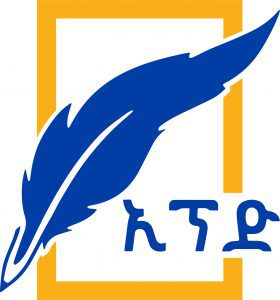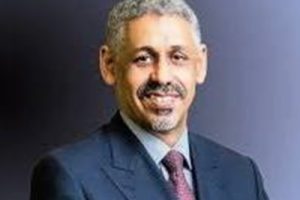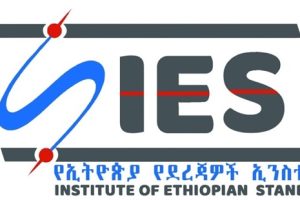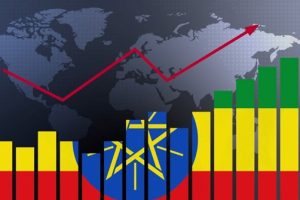
Beneath the crimson eaves of Hanoi’s 1,500-year-old Tran Quoc Pagoda, Ethiopian Prime Minister Abiy Ahmed (PhD) and Vietnamese Prime Minister Pham Minh Chinh shared a bowl of pho, marking a pivotal moment in bilateral relations. Over six days (April 14–19), Abiy’s visit to Vietnam transformed a historically cordial friendship into a dynamic South-South partnership. Their 24-point communiqué, signed during the 2025 P4G Summit, spans smart-city engineering, climate-smart manufacturing, cultural exchange, and directC flights between Addis Ababa and Ho Chi Minh City. This aspiring agenda positions Ethiopia to draw lessons from Vietnam’s post-war economic miracle while offering Vietnam a foothold in Africa’s second-most-populous market.
Shared histories of resilience
The rapport between Addis Ababa and Hanoi is rooted in parallel anti-colonial triumphs. Ethiopia’s 1896 victory at the Battle of Adwa, the first African defeat of a European colonial power, sparked pan-African liberation. Vietnam’s expulsion of France in 1954 and the U.S. by 1975, epitomized by the Củ Chi tunnels, cemented its global stature. “Both nations showed that mobilized citizens can outmatch superior firepower,” said Mulugeta Ayele, a peace and security scholar at Addis Ababa University. This shared ethos of suspicion of external control, firmness for sovereignty, and state-led development-continues to shape their political DNA.
Reviving an undeveloped bond
Diplomatic ties, established in 1976 between Ethiopia’s Marxist Derg and unified Vietnam, remained sporadic amid internal turmoil. Ties warmed under Ethiopia’s late Prime Minister Meles Zenawi and Vietnam’s President Trần Đại Quang’s 2018 visit, but lacked sustained momentum. Abiy’s trip, coinciding with the P4G Summit, reinvigorated relations. In three days, the delegations signed nine memoranda covering investment, education, aviation, agriculture, digital finance, and heritage tourism, laying the groundwork for deeper collaboration.
Vietnam’s economic blueprint
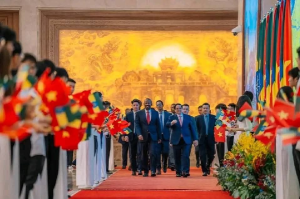
Vietnam’s rise from war-torn fields to a “Tiger Cub” economy is a global case study. Its 1986 Đổi Mới reforms legalized private enterprise, opened trade, and attracted foreign investment through streamlined licensing. GDP per capita grew nearly tenfold, driven by coffee, rice, textiles, footwear, electronics, and agro-processing. Industrial zones flourished along the Red River and Mekong deltas, with the private sector’s industrial output rising from 25% in 1991 to 53% in 2023. The Củ Chi tunnels, once a guerrilla stronghold, now attract over two million tourists annually, while Ho Chi Minh City’s Thu Thiem peninsula has transformed from swamp to a smart district with metro lines and fiber-optic networks. Vietnam’s nationalism is woven into education, museums, and a mandatory 18-month rural service for university students, linking elites to rural realities.
Lessons for Ethiopia
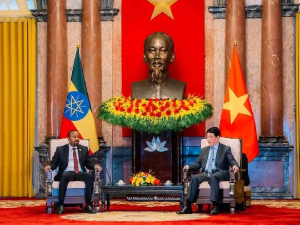
Ethiopia’s Home-Grown Economic Reform 2.0 targets quadrupling manufacturing, surpassing 20 billion USD in exports, and establishing ten agro-industrial parks by 2030. Vietnam, with its agrarian, war-torn origins, provides a practical blueprint. Key lessons include education reform, where Vietnam replaced colonial curricula with STEM-focused, patriotic syllabi. Addis Ababa University is adapting Vietnamese civics texts for certain schools. Smart-city planning is another focus: Hanoi’s western corridor blends rapid buses, cycle lanes, and green spaces. A new MoU enlists Vietnam’s Urban Planning Institute to train 60 Ethiopian engineers yearly and guide two bus rapid-transit lines in Addis Ababa. Additionally, Vietnam’s value-chain success-boosting coffee profits through instant-coffee plants and branding-inspires a proposed Ethiopian-Vietnamese coffee innovation center in Jimma to develop soluble blends and geographic-indicator labels.
Agricultural cities and tourism
Vietnam’s “city agriculture”— rooftop hydroponics, peri-urban mushroom farms, and aquaponic systems—supplies urban markets. With Ethiopia importing 70% of its vegetables, Addis Ababa University is sending agronomists to study Ho ChiMinh City’s vertical-farming pilots, co-funded by the Asian Development Bank. Tourism offers another lesson: Củ Chi generates millions annually with candid war narratives. Ethiopia, with Adwa, Lalibela, and the Rift Valley, has untapped potential. The Adwa Victory Museum is a step forward, but officials seek Vietnam’s expertise in marketing and hospitality training.
Economic synergies
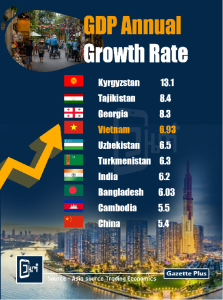
Bilateral trade, at 50 million USD in 2024, is modest but promising. Ethiopia exports hides, coffee, and garments; Vietnam supplies sewing machines, agro-chemicals, and electronics. Vietnamese apparel firms eye Ethiopia’s duty-free access to Europe and the U.S., cheap hydropower, and 60-million-strong workforce, while Ethiopia seeks Vietnam’s process engineering and buyer networks. Toyo Solar’s 2024 photovoltaic assembly in Hawassa Industrial Park led to a letter of intent for a 200 MW solar farm in Oromia, supporting Ethiopia’s Green Legacy Initiative. If realized, it would be Vietnam’s largest African investment.
Vietnamese logistics firms are eyeing Ethiopia’s railway rehabilitation and Mojo dry port. Saigon Newport Corporation offered to manage container yards, while VietJet Air explores cargo links with Ethiopian Airlines’ freighter network. For Vietnam, with 25 billion USD in outbound investment, Ethiopia is a gateway to COMESA’s 560-million-consumer market.
Climate as diplomatic glue
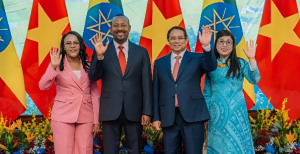
Both nations use green growth to bolster legitimacy. Ethiopia’s Green Legacy, aiming to plant 7.5 billion seedlings by 2025, and Vietnam’s net-zero 2050 commitment position climate action as soft power. The Hanoi communiqué details collaborative
projects in solar irrigation, bamboo panel production, and carbon offsets. Ethiopian agronomists will trial Vietnamese drip-irrigation kits on Awash sesame fields, while Hanoi’s Institute of Tropical Technology tests Ethiopian bamboo for flooring targeted at the Japanese market.
Operationalizing the vision
Success depends on practical agreements. The Joint Commission on Economic and Technical Cooperation, inactive since 2014, must be revived to harmonize investment codes. Ethiopian Airlines and Vietnam Airlines are studying a thrice-weekly Addis–Ho Chi Minh City route by 2026, with connections to Lagos and Tokyo. Vietnam’s Academy of Social Sciences will host Ethiopian textile chemistry postgraduates, and Ethiopian Railways will invite Vietnamese contractors to bid on the Mojo–Hawassa freight corridor. A double-taxation treaty and visa waivers for business travelers are set for 2026.
Social cohesion strategies
Ethiopia launched a National Dialogue Commission to resolve the longstanding and contentious challenges in peaceful and lasting manner and Vietnam’s reconciliation model—minority-hero statues, bilingual museum plaques, and inclusive road names—offers inspiration. Vietnamese facilitators will share village-level dialogue and truth-memorial techniques, fostering unity without stifling debate.
Opportunities and challenges ahead
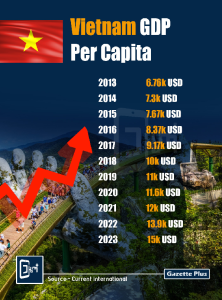
Ethiopia presents a promising market for Vietnamese businesses aiming to expand their presence in the Horn of Africa, competing with China and Turkey for contracts. By adopting a single-window permitting system, Ethiopia significantly speeds up its industrial park approvals and making itself a more attractive place for Vietnamese investors. However, logistical hurdles, infrastructure limitations, along with inconsistent intellectual property and import clearance regulations pose challenges. By addressing these obstacles, Ethiopia can advance its position as a key destination for Vietnamese investment.
Geopolitical balancing act
Abiy and Pham must manage external pressures. China, Ethiopia’s top creditor and Vietnam’s largest trade partner, requires reassurance that their partnership complements Beijing’s interests. The U.S., eyeing both for Indo-Pacific and Horn strategies, ties aid to governance. Balancing these while advancing bilateral goals demands diplomatic finesse.
Cultural diplomacy
The pagoda breakfast carried deep symbolism
Ethiopia’s Orthodox Archbishop Abune Petros and Vietnam’s Buddhist Patriarch Thích Thanh Nhiễu discussed heritage preservation. Reciprocal exhibitions—Lalibela’s Rock-Hewn Churches in Hanoi, Cham temple reliefs in Addis—will deepen ties. Ethiopian jazz will feature at Ho Chi Minh City’s World Music Festival, and Vietnamese water-puppet troupes will tour Ethiopian schools, humanizing technical agreements.
A roadmap for collaboration
Vietnam’s late-industrialization model and Ethiopia’s resources and market potential align logically. Pilot projects—smart-city workshops, coffee branding, bamboo composites, solar irrigation-are modest but actionable. Success could spur broader trade, technology transfer, and shared narratives, turning pagoda symbolism into tangible supply chains.
A partnership born over pho
Pham’s choice of Tran Quoc Pagoda, Vietnam’s oldest Buddhist site, for Abiy’s breakfast underscored resilience and renewal. Their shared meal marked a pivot for two nations, once defined by survival, toward inclusive growth and climate leadership. The task now is to translate goodwill into clear rules, timely financing, and measurable outcomes. If successful, this pagoda diplomacy could accelerate Ethiopia’s industrial ambitions and secure Vietnam’s stake in Africa’s rising rim—a partnership forged over a humble bowl of pho.
BY MEKEDS TAYE (PHD)
APRIL29/2025
